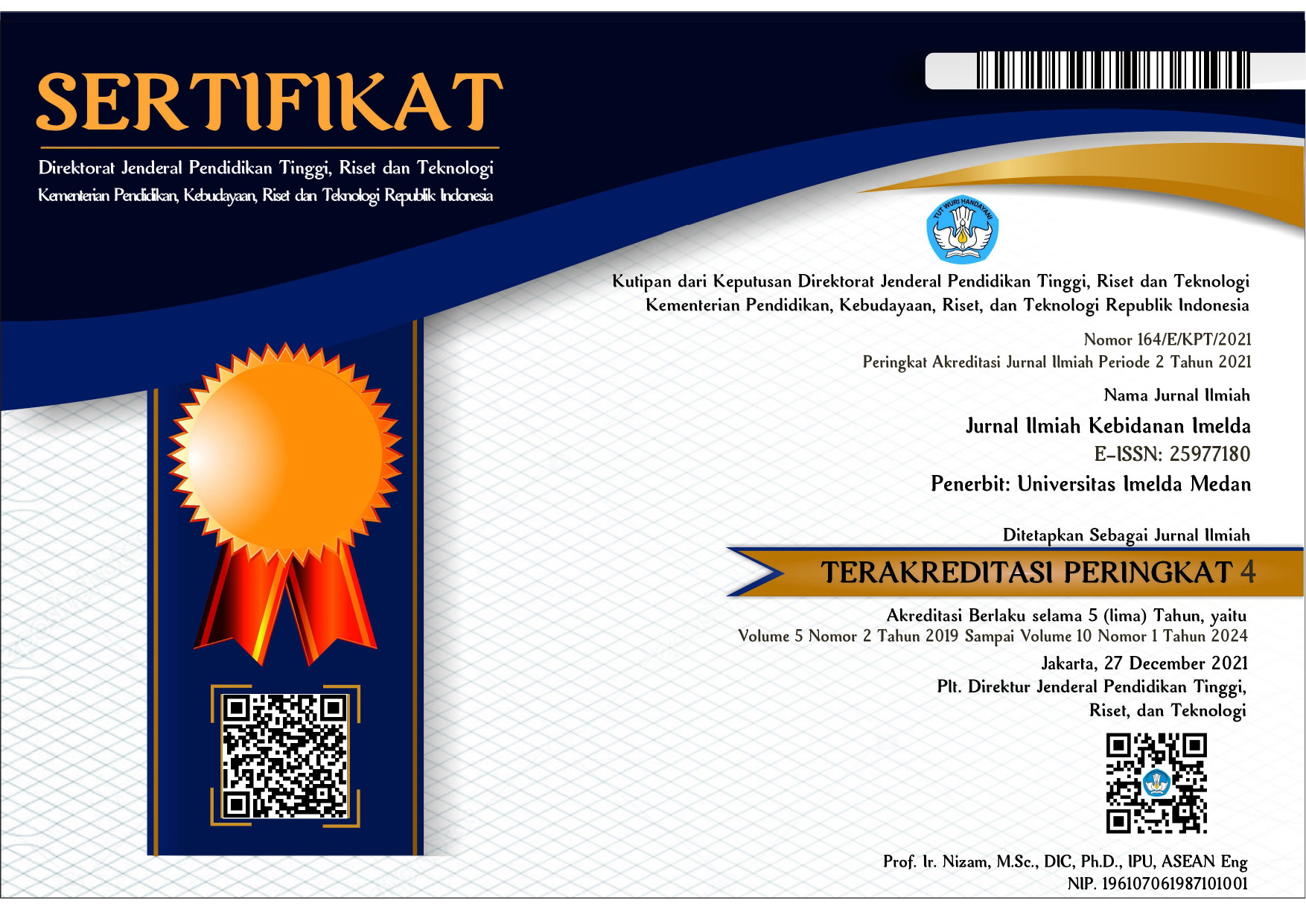HEALTH BELIEF MODEL PADA IBU HAMIL DALAM PERILAKU MENGHITUNG GERAK JANIN
DOI:
https://doi.org/10.52943/jikebi.v10i2.1633Keywords:
Health Belief Model, Fetal Movement Counting, PregnancyAbstract
Monitoring the well-being of the fetus is an important part of the management of pregnancy and childbirth. Health Belief Model (HBM) is a model of individual health beliefs in determining attitudes to do or not to do health behavior. The purpose of this study was to describe the description of the Health Belief Model in pregnant women in the behavior of counting fetal movements during pregnancy. This type of research is descriptive quantitative with a total sample of 30 pregnant women who have felt fetal movement. The sampling technique uses accidental sampling. The research was conducted in July 2022 at PMB Santi Rahayu, Malang Regency. The research instrument used the Health Belief Model questionnaire. The results showed that the most negative perceptions were in the perceived barriers variable (60%) and positive perceptions in the cues to action variable (60%). From the result of the researh it is hoped that midwives can teach how to calculate fetal movement so that pregnant women can apply it independently.
References
F. Yani, D. R. Adila, and R. Roslita, “Tingkat pengetahuan ibu tentang pemantauan gerakan janin pada ibu hamil dengan preeklampsia,” Jurnal Cakrawala Promkes, vol. 3, no. 1, 2021, doi: 10.12928/promkes.v3i1.2848.
L. L. Sari, “Faktor-Faktor yang Berhubungan dengan Kejadian Intra Uterine Fetal Death (IUFD) pada Ibu Bersalin di RSUD Hasanuddin Damrah Manna,” Jurnal Sains Kesehatan, vol. 28, no. 1, 2021, doi: 10.37638/jsk.28.1.25-33.
C. Mariani, Arrifah Noer Emma, “Faktor-Faktor yang Berhubungan dengan Pengetahuan Ibu Hamil Tentang Tanda Tanda Bahaya Kehamilan,” zona Kebidanan, vol. 10, no. 2, 2020.
C. Z. Jannetia, I. Yudianti, and I. Yuliani, “Women’s Anxiety and Fetal Movement in the 3rd Trimester of Pregnancy,” EMBRIO, vol. 15, no. 2, pp. 197–206, 2023.
I. Yudianti and R. Nurhayati, “Health Belief Model (HBM) dan Keterlambatan Rujukan Kasus Ginekologi,” MIKIA: Mimbar Ilmiah Kesehatan Ibu dan Anak (Maternal and Neonatal Health Journal), 2015, doi: 10.36696/mikia.v2i1.33.
N. Wahyunia Utami and M. Putri Rahmadhena, “Gambaran Penerapan Health Belief Model Pada Balita Stunting Di Wilayah Puskesmas Minggir Sleman,” INVOLUSI: Jurnal Ilmu Kebidanan, vol. 10, no. 1, 2020, doi: 10.61902/involusi.v10i1.127.
R. C. Puspita, D. Tamtomo, and D. Indarto, “Health Belief Model for the Analysis of Factors Affecting,” Journal of Health Promotion and Behavior, vol. 2, no. 2, 2017.
W. Setyaningsih, I. Yudianti, and H. Mansur, “Perceived susceptibility, barriers, and cues to action as determinant factors of reproductive health behavior,” Int J Publ Health Sci, vol. 11, no. 3, 2022, doi: 10.11591/ijphs.v11i3.21576.
T. K. Dewi, K. Massar, R. A. C. Ruiter, and T. Leonardi, “Determinants of breast self-examination practice among women in Surabaya, Indonesia: An application of the health belief model,” BMC Public Health, vol. 19, no. 1, Nov. 2019, doi: 10.1186/s12889-019-7951-2.
Ika Yudianti, Dessy Amelia, Nur Eva Aristina, and Nina Primasari, “Pregnant Women Empowerment in Monitoring Fetal Wellbeing Through Fetal Movement Count Mobile Application,” SEAJOM: The Southeast Asia Journal of Midwifery, vol. 8, no. 2, 2022, doi: 10.36749/seajom.v8i2.184.
F. Bayat, D. Shojaeezadeh, M. s, R. Heshmat, M. Baikpour, and M. Hosseini, “The effects of education based on extended health belief model in type 2 diabetic patients: A randomized controlled trial,” J Diabetes Metab Disord, vol. 12, no. 1, 2013, doi: 10.1186/2251-6581-12-45.
E. Edmonds, L. W. Turner, and S. L. Usdan, “Osteoporosis knowledge, beliefs, and calcium intake of college students: Utilization of the health belief model,” Open J Prev Med, vol. 02, no. 01, 2012, doi: 10.4236/ojpm.2012.21005.
J. Moudy and R. A. Syakurah, “Pengetahuan terkait usaha pencegahan Coronavirus Disease (COVID-19) di Indonesia,” Higeia Journal of Public Health Research and Development, vol. 4, no. 3, 2020.
L. M. Sirait and S. Sarumpaet, “Hubungan Komponen Health Belief Model (HBM) dengan Penggunaan Kondom pada Anak Buah Kapal (ABK) di Pelabuhan Belawan,” Jurnal Precure, vol. 1, no. 1, 2012.
V. Champion and C. Skinner, “The health belief model. Health behavior and health education,” Health Behavior and Health Education: Theory, research, and practice, vol. 4, 2008.
S. I. Onoruoiza, A. Musa, B. D. Umar, and Y. S. Kunle, “Using Health Beliefs Model as an Intervention to Non Compliance with Hypertension Information among Hypertensive Patient,” International Organization of Scientific Research Journal Of Humanities And Social Science, vol. 20, no. 9, 2015.
Glanz, Health Behaviour And Health Education Theory, Research, And Practice 4th Edition. 2008.
Salmah, “Asuhan Kebidanan Antenatal,” in Jakarta: EGC, 2013.
M. Delaram and L. Jafarzadeh, “The effects of fetal movement counting on pregnancy outcomes,” Journal of Clinical and Diagnostic Research, vol. 10, no. 2, 2016, doi: 10.7860/JCDR/2016/16808.7296.
D. E. Yehualashet, B. T. Seboka, G. A. Tesfa, A. D. Demeke, and E. S. Amede, “Barriers to the adoption of electronic medical record system in ethiopia: A systematic review,” J Multidiscip Healthc, vol. 14, 2021, doi: 10.2147/JMDH.S327539.
“Health Promotion Theory Edited by Maggie Davies and Wendy Macdowall,” Health Promotion Journal of Australia, vol. 17, no. 2, 2006, doi: 10.1071/he06156.
W. C. Rachmawati, Promosi Kesehatan dan Ilmu Perilaku Kesehatan. 2019.
E. Vasra and A. Noviyanti, “Membangun Body Image Ibu Hamil Terintegrasi Hypnosis Dalam Upaya Pemantauan Kesejahteraan Janin,” Journal of Community Engagement in Health, vol. 4, no. 1, 2021.
H. P. Astuti, “Hubungan Karakteristik Ibu Hamil dengan Tingkat Pengetahuan Tentang Tanda Bahaya pada Kehamilan di Puskesmas Sidoharjo Kabupaten Sragen,” Jurnal Kesehatan Kusuma Husada, vol. 3, no. 2, 2017.
A. Hutagaol, “Tingkat Pengetahuan Ibu Tentang Inisiasi Menyusu Dini (IMD) di Rumah Sakit Umum Daerah Deli Serdang Lubuk Pakam,” Jurnal Ilmiah Keperawatan Imelda, vol. 2, no. 1, 2016.
Abner naa, “Pengaruh Lingkungan Kerja, Motivasi Kerja Dan Pelatihan Terhadap Kinerja Pegawai Di Kantor Distrik Bintuni Kabupaten Teluk Bintuni,” Jurnal Renaissance, vol. 2, no. 02, 2017.
W. Ding, T. Li, Q. Su, M. Yuan, and A. Lin, “Integrating factors associated with hypertensive patients’ self-management using structural equation modeling: A cross-sectional study in Guangdong, China,” Patient Prefer Adherence, vol. 12, 2018, doi: 10.2147/PPA.S180314.
Irwan, “Etika dan Perilaku Kesehatan skripsi <3,” Yogyakarta, Absolute Media, 2020.
E. Winarti, “Pengaruh Self Efficacy Terhadap Pelaksanaan Deteksi Dini Kanker Serviks Metode IVA di Puskesmas Kota Kediri,” Journal of Public Health Research and Community Health Development, vol. 2, no. 2, 2019, doi: 10.20473/jphrecode.v2i2.12231.










